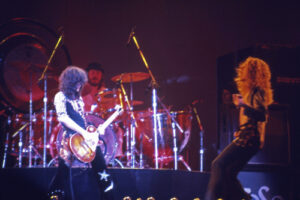
Feature Photo: Arthur D’Amario III / Shutterstock.com
# 10 – Space Truckin’ – Deep Purple
“Space Truckin’” is the closing track on Machine Head, the iconic 1972 album by Deep Purple. The song stands out not just as a hard rock anthem but as an exhilarating ode to space travel, complete with high-energy riffs and sci-fi-inspired lyrics. Guitarist Ritchie Blackmore was heavily influenced by the half-step riff structure used in the Batman TV theme, and this unique approach shaped the song’s rhythm and feel. Lead vocalist Ian Gillan then took those riffs and wrote lyrics that would transform the song into an interstellar adventure. The song’s narrative revolves around the band “trucking” through the cosmos, having a blast with aliens and dancing across the planets.
Read More: Steve Morse Interview: Deep Purple Road Stories
# 9 – Outta Space – Billy Preston
“Outa-Space” is an instrumental track by the legendary musician Billy Preston, featured on his 1971 album I Wrote a Simple Song. The instrumental’s distinctive sound came from Preston’s innovative use of a clavinet run through a wah-wah pedal, creating a futuristic and funky atmosphere. This track was born out of an improvisational session, where Preston was calling out chord changes to his backing band as they jammed. He later added layers of organ and hand claps to give the song its final, spacey texture. The track was so otherworldly that Preston aptly titled it “Outa-Space.”
Initially released as the B-side to the single “I Wrote a Simple Song,” A&M Records had little confidence in the instrumental’s success. However, radio DJs flipped the single, and “Outa-Space” rapidly gained popularity, far outshining its A-side. The track soared to number 2 on the Billboard Hot 100, only being held off the top spot by Bill Withers’ “Lean on Me.” Despite being a B-side, “Outa-Space” dominated the R&B charts, reaching number 1, and it eventually earned Billy Preston a Grammy Award for Best Pop Instrumental Performance in 1972. The instrumental’s popularity extended beyond the U.S., as it also peaked at number 44 on the UK Singles Chart.
Read More: Top 10 Billy Preston Songs
# 8 – Space Station # 5 – Montrose
“Space Station #5” is a standout track from Montrose’s debut album, Montrose, released in October 1973. This song encapsulates the band’s futuristic and heavy rock sound, showcasing a blend of sci-fi themes with hard rock energy. Written by guitarist Ronnie Montrose and vocalist Sammy Hagar, the track is a space-faring anthem that explores themes of leaving Earth behind and embarking on a cosmic journey to a better future. The song’s title and lyrics reference a fictional space station as a destination in the band’s vision of space travel, making it a perfect fit for this list of the best rock songs about space.
Read More: Complete List Of Montrose Albums And Discography
# 7 – Cygnus X-1 – Rush
“Cygnus X-1” is a space odyssey in the form of progressive rock, crafted by the legendary Canadian trio Rush. The song is the final track on their 1977 album A Farewell to Kings and is considered one of the most complex and musically ambitious pieces in their catalog. I saw this tour, and the band was just killing it on stage. “Cygnus X-1” is split into multiple parts, with the first section, “Book I: The Voyage,” found on A Farewell to Kings. The second part, “Book II: Hemispheres,” continues the story on their 1978 album Hemispheres. This sprawling track takes listeners on a journey to the mysterious black hole in the constellation of Cygnus, blending science fiction, philosophy, and intense musicianship, making it a fitting addition to any list of the best rock songs about space.
Read More: Alex Lifeson of Rush: The ClassicRockHistory.com Interview
# 6 – Calling Occupants Of Interplanetary Craft – Klaatu
# 5 – Set The Controls For The Heart Of The Sun – Pink Floyd
Set the Controls for the Heart of the Sun by Pink Floyd is one of the band’s earliest explorations into space-themed rock, encapsulating their sound’s cosmic and experimental nature. Featured on their 1968 album A Saucerful of Secrets, the song was written by Roger Waters and includes contributions from all five band members: Roger Waters, Syd Barrett, David Gilmour, Richard Wright, and Nick Mason. This track holds the unique distinction of being the only one in the Pink Floyd catalog that features both Barrett and Gilmour on guitars, even though Barrett’s involvement was waning due to his struggles.
Read More: Ultimate Pink Floyd Page: Complete History, Songs, Albums & More
# 4 – Starship Trooper – Yes
Starship Trooper by Yes is an ambitious progressive rock epic that first appeared on the band’s 1971 album, The Yes Album. Written by Jon Anderson, Steve Howe, and Chris Squire, the song is divided into three parts: Life Seeker, Disillusion, and Würm, each written by different band members and stitched together to create an evolving, dynamic piece. The song reflects both the experimental nature of progressive rock and the philosophical, cosmic themes that would come to define much of Yes’ music in the 1970s. With its intricate arrangements, shifting time signatures, and multi-layered structure, Starship Trooper offers a musical journey through space, spirituality, and self-discovery.
Read More: An Interview With Oliver Wakeman, Formerly Of Yes
# 3 – Rocket Man – Elton John
Rocket Man (I Think It’s Going to Be a Long, Long Time) is one of Elton John’s most iconic tracks, released in 1972 as the lead single from his Honky Château album. This is easily one of Elton John’s most loved albums and I know I’ve written about this in the past, defining it as a turning point in his career where he kind of crosses over from his Americana sound into the pop world in which he would just continue to release hit after hit for the next 3 years. Written in collaboration with his longtime lyricist Bernie Taupin, the song draws from themes of isolation, duty, and the emotional toll of space travel. The song was a huge commercial success, peaking at No. 2 on the UK Singles Chart and reaching No. 6 in the U.S. on the Billboard Hot 100.
Read More: Complete List Of Elton John Articles
# 2 – Spaceman – Harry Nilsson
“Spaceman,” by Harry Nilsson, was released in 1972 on his album Son of Schmilsson. It is a brilliant fusion of folk, rock, and R&B that tells the story of a once-aspiring astronaut who now longs to return to Earth. The song’s narrative unfolds with a mix of humor and melancholy as the protagonist, stuck in space, expresses regret over his decision to leave Earth. Nilsson’s knack for blending quirky storytelling with emotive songwriting is fully displayed in “Spaceman,” making it a standout track from the album..
Read More: Top 10 Harry Nilsson Songs
# 1 – Space Oddity – David Bowie
David Bowie’s Space Oddity, first released as a single on July 11 1969 and later included as the opening track on his self-titled second studio album, is one of the most iconic rock songs to explore the theme of space travel. Written at a time when the world was gripped by space race fever, the song introduces listeners to Major Tom, a fictional astronaut whose journey into space leads to a haunting sense of isolation and uncertainty. Drawing inspiration from Stanley Kubrick’s film 2001: A Space Odyssey, the track reflects both the wonder and loneliness of space exploration, paralleling Bowie’s own feelings of alienation in his career.
Produced by Gus Dudgeon and recorded at Trident Studios in London, Space Oddity marked a departure from Bowie’s earlier, more music hall-inspired work, moving towards a sound influenced by psychedelic folk. The song’s instrumentation was revolutionary for its time, combining acoustic guitar, stylophone (played by Bowie), Mellotron, and subtle orchestration to create an atmosphere of weightlessness. The production and arrangement, along with the song’s narrative structure, helped propel Bowie into a new phase of his career, solidifying his place as a master of sonic storytelling. The lineup of musicians on the track includes Mick Wayne on guitar, Herbie Flowers on bass, Terry Cox on drums, and Rick Wakeman on the Mellotron, adding to its distinctive soundscape.
Initially released to coincide with the Apollo 11 moon landing, Space Oddity became a commercial success in the UK, where it reached No. 5 on the charts. It wasn’t until its reissue in 1972 that the song gained traction in the United States, reaching No. 15 on the Billboard Hot 100. Eventually, a 1975 reissue helped it become Bowie’s first UK No. 1 hit. The song’s narrative revolves around Major Tom, who, after launching into space, finds himself adrift and disconnected from Ground Control, symbolizing feelings of disconnection and existential crisis. The lyrics “For here am I sitting in a tin can / Far above the world / Planet Earth is blue, and there’s nothing I can do” poignantly express his isolation and helplessness, offering a reflection on the fragility of human existence in the vastness of space.
Read More: Stevie Ray Vaughan David Bowie Tour: Why It Never Happened.
Updated September 26, 2025

![Machine Head [CD]](http://m.media-amazon.com/images/I/51Th2pnwMeL._SL500_.jpg)


![A Farewell To Kings [40th Anniversary 3 CD]](http://m.media-amazon.com/images/I/51jjE+UKKvL._SL500_.jpg)








































